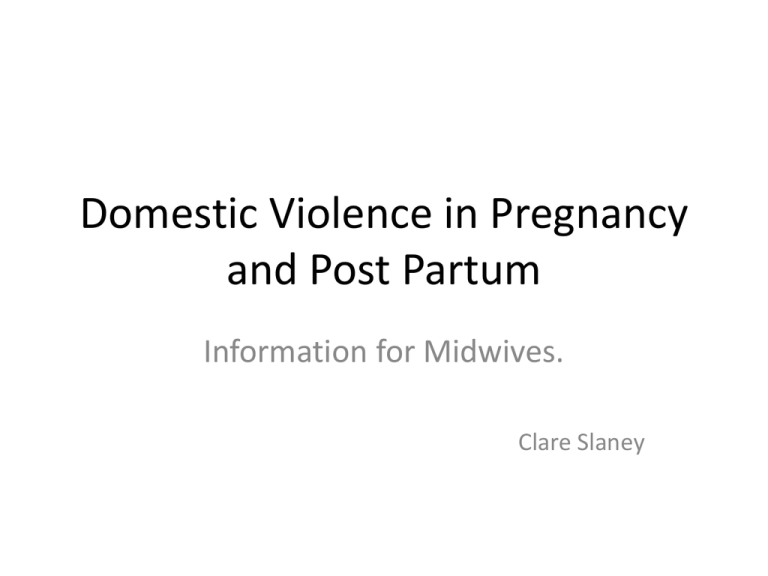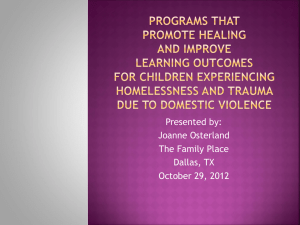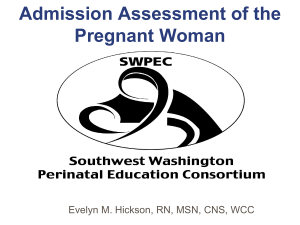
Domestic Violence in Pregnancy
and Post Partum
Information for Midwives.
Clare Slaney
Home Office Definition
Any incident or pattern of incidents of controlling, coercive, threatening behaviour,
violence or abuse between those aged 16 or over who are, or have been, intimate
partners or family members regardless of gender or sexuality. The abuse can
encompass, but is not limited to:
•
•
•
•
•
psychological
physical
sexual
Financial
Emotional 1
Home Office is considering adding the term Coercive Control2 to the definition.
1 November 2013 https://www.gov.uk/domestic-violence-and-abuse
2 https://www.gov.uk/government/uploads/system/uploads/attachment_data/file/157800/domestic-violencedefinition.pdf
How many women experience
domestic violence?
•
•
•
•
•
Official figures 1 in 4
Recent YouGov research suggests 1 in 3
One in six pregnant women will experience domestic violence.
30% of domestic violence starts or worsens during pregnancy.
Domestic violence is a factor in a significant proportion of maternal and
perinatal mortality and morbidity.
• Compare to incidence of conditions routinely investigated during
pregnancy.
For a discussion of the statistics please visit
http://www.womensaid.org.uk/domestic_violence_topic.asp?section=0001000100220036sionTitle=statistics
Incidence in pregnancy
• In a study examining the prevalence of
domestic violence and its associations with
obstetric complications and psychological
health, 23% of women had a lifetime
experience of domestic violence, and 3% had
experienced violence in the current pregnancy
- probably an under-estimate . The effects can
be cumulative and long-lasting; so abuse prior
to the current pregnancy could result in
adverse effects for mother and child. (2004)
Miscarriage and premature birth
• Injury to the abdomen, breasts and genitals are common.
• Violence during pregnancy can cause placental separation, foetal
fractures, antepartum haemorrhage, rupture of the uterus and preterm labour.
• Abuse can also indirectly impact upon the health of a woman and
her baby through poor diet and restricted access to antenatal care.
• In 2000, the Department of Health, Royal College of Obstetricians
and Gynaecologists, the Royal College of Midwives, and NICE
endorsed routine antenatal enquiry for domestic violence.
• 2001 recommended that all pregnant women should be asked
routinely about domestic abuse as part of their social history.
DV and maternal death
• 12% of the 378 women whose death was
reported to the Confidential Enquiry on
Maternal Deaths had voluntarily reported
domestic violence to a healthcare professional
during their pregnancy. None had routinely been
asked about domestic violence so this is almost
certainly an under-estimate. (2001)
Lewis, Gwynneth, Drife, James, et al. (2001) Why mothers die: Report from the confidential enquiries into
maternal deaths in the UK 1997-9; commissioned by Department of Health from RCOG and NICE (London:
RCOG Press); also Why Mothers Die 2000-2002 - Report on confidential enquiries into maternal deaths in the
United Kingdom (CEMACH.
What pregnant women want
• Routine enquiry about domestic violence in maternity
settings is accepted by women.
• Disclosures of violence require privacy, confidentiality
and sensitive questioning by non-judgmental staff.
Women may not disclose violence unless asked directly.
• Often women do not understand the failure of health
professionals to ask in depth about the cause of their
injuries or health problems.
Role of the Midwife
Royal College of Midwives, 2006
• The midwife is ideally placed to identify ongoing abuse and to offer
care, support and information to women. However, this contribution
is often hampered by poor coordination of services, by inadequate
knowledge of domestic abuse and its complexities and by midwives’
own experiences, beliefs and attitudes concerning domestic abuse.
• The RCM supports routine enquiry into domestic abuse throughout
pregnancy and the postnatal period, which is accompanied by a
package of measures that includes a systematic and structured
framework for referral and support for women who disclose domestic
abuse.
Role of the midwife cont
NICE, 2001
• All women should be routinely asked about
domestic violence as part of their social history.
• Women should have the opportunity to discuss
their pregnancy with a midwife in privacy, without
their partner present, at least once in the antenatal
period.
Role of the midwife cont
NICE Pregnancy and Complex Social Factors, 2010
Women who experience domestic abuse should be
supported in their use of antenatal care services by:
Training healthcare professionals in the identification and
care of women who experience domestic violence
Making available information and support tailored to
women who experience or are suspected to be experiencing
domestic violence
Providing a more flexible series of appointments if needed
Addressing women’s fears about the involvement of
Children’s Services by providing information tailored to their
needs.
Role of the midwife cont
Centre for Maternal and Child Enquiries, 2011
• Continuing recommendation that routine enquiry,
‘asking the question’, should be made about domestic
violence, either when taking a social history at booking
or at another opportune point during a woman’s
antenatal period. Midwives should give high priority to
‘asking the question’ and to giving information to all
women about domestic violence.
• All women should be seen alone at least once during
the antenatal period to facilitate disclosure of domestic
violence.
Barriers to disclosure
• Fear of an unsympathetic response
• Fear of reprisals and serious escalation of violence from their partner if they
get outsiders involved
• Shame and embarrassment over what has happened to them
• Fear that children will be taken into care
• Lack of awareness that help might be obtained from health professionals
• Fear of police or other authorities being contacted and – for some black and
minority ethnic women – fear of deportation^.
How to support women experiencing
DV
• Do not judge. If she could have left she would have.
• Create a relationship. Women who experience DV have
often been let down by other professionals.
• Be direct: “I’m worried about you.” “Remember these
meetings are confidential.”
• Believe her. DV survivors are often not believed.
• Reassure her that the abuse is not her fault.
• Women have to leave when they are ready. The most
dangerous point for women (and children) who
experience DV is at the point of separation and
immediately after leaving an abusive partner.
How to support women
experiencing DV cont
• It takes strength and courage to leave. She
may have nowhere to go, no money and her
children may be held to ransom.
• Put her in touch with local, good DV agencies,
especially IDVA’s.
• Be patient. Denial is powerful and women are
often very isolated.
• Encourage her. Tell her that she’s doing well
against very high odds.
Barriers to midwives asking about DV
• Fear of starting something that will get out of
control
• Fear of not knowing what to do next
• Fear of causing offence
• Belief that DV is a private matter
• Identification as either as a victim or perpetrator
Multi Agency Risk Assessment
Conference (MARAC)
• Local, victim-focused, information sharing between statutory and
voluntary sector agencies.
• The risk assessment process –referrals, procedures and standards – are
developed by Coordinated Action Against Domestic Abuse (CAADA), a
national organisation supported by the Home Office.
• Role of the MARAC is to facilitate, monitor and evaluate effective
information sharing to enable appropriate actions to be taken to
increase public safety. In a single meeting the MARAC combines up to
date risk information with a timely assessment of a victims needs and links
those directly to the provision of appropriate services for all those
involved in a domestic violence case; victim, children perpetrator and
agency workers.
• An individualised multi-agency action plan is created to support the victim
and to make links with other public protection procedures, particularly
those that safeguard children and vulnerable adults. Issues relating to
children such as conflict over child contact, pregnancy and perception of
harm to children are key indicators of risk in the CAADA risk.











